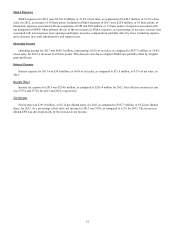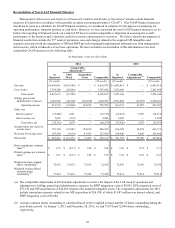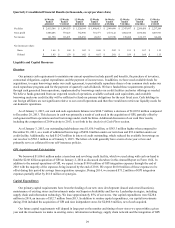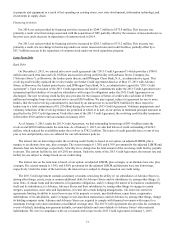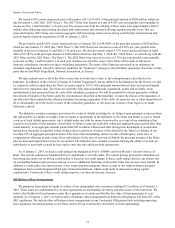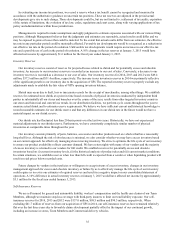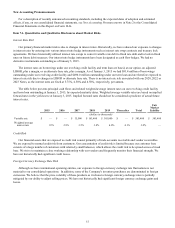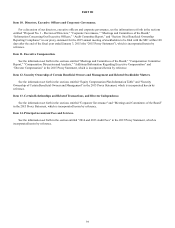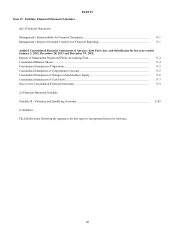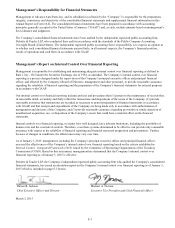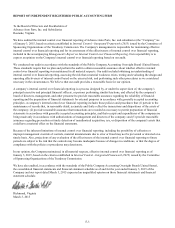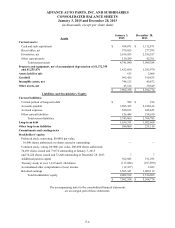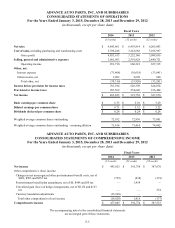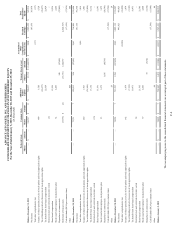Advance Auto Parts 2014 Annual Report Download - page 43
Download and view the complete annual report
Please find page 43 of the 2014 Advance Auto Parts annual report below. You can navigate through the pages in the report by either clicking on the pages listed below, or by using the keyword search tool below to find specific information within the annual report.36
Our self-insurance reserves consist of the estimated exposure for claims filed, claims incurred but not yet reported and
projected future claims, and are established using actuarial methods followed in the insurance industry and our historical claims
experience. Specific factors include, but are not limited to, assumptions about health care costs, the severity of accidents and
the incidence of illness and the average size of claims. Generally, claims for automobile and general liability and workers’
compensation take several years to settle. We classify the portion of our self-insurance reserves that is not expected to be settled
within one year in long-term liabilities.
While we do not expect the amounts ultimately paid to differ significantly from our estimates, our self-insurance reserves
and corresponding SG&A could be affected if future claim experience differs significantly from historical trends and actuarial
assumptions. A 10% change in our self-insurance liabilities at January 3, 2015 would have affected net income by
approximately $8.7 million for the fiscal year ended January 3, 2015.
Vendor Incentives
We receive incentives in the form of reductions to amounts owed and/or payments from vendors related to cooperative
advertising allowances, volume rebates and other promotional considerations. Many of these incentives are under long-term
agreements (terms in excess of one year), while others are negotiated on an annual basis or less (short-term). Volume rebates
and cooperative advertising allowances not offsetting in SG&A are earned based on inventory purchases and initially recorded
as a reduction to inventory. These deferred amounts are included as a reduction to cost of sales as the inventory is sold.
Cooperative advertising allowances provided as a reimbursement of specific, incremental and identifiable costs incurred to
promote a vendor’s products are included as an offset to SG&A when the cost is incurred. Certain of our vendor agreements
contain purchase volume incentives that provide for increased funding when graduated purchase volumes are met. Amounts
accrued throughout the year could be impacted if actual purchase volumes differ from projected annual purchase volumes.
Total deferred vendor incentives included in inventory was $179.8 million and $111.3 million as of January 3, 2015 and
December 28, 2013, respectively.
Similarly, we recognize other promotional incentives earned under long-term agreements as a reduction to cost of sales.
However, these incentives are recognized based on the cumulative net purchases as a percentage of total estimated net
purchases over the life of the agreement. Short-term incentives (terms less than one year) are generally recognized as a
reduction to cost of sales over the duration of any short-term agreements.
Amounts received or receivable from vendors that are not yet earned are reflected as deferred revenue. Management’s
estimate of the portion of deferred revenue that will be realized within one year of the balance sheet date is included in Other
current liabilities. Earned amounts that are receivable from vendors are included in Receivables, net except for that portion
expected to be received after one year, which is included in Other assets, net. We regularly review the receivables from vendors
to ensure they are able to meet their obligations. Historically, the change in our reserve for receivables related to vendor
funding has not been significant. A 10% difference in our vendor incentives deferred in inventory at January 3, 2015 would
have affected net income by approximately $11.4 million for the fiscal year ended January 3, 2015.
Warranty Reserves
We offer limited warranties on certain products that range from 30 days to lifetime warranties; the warranty obligation on
the majority of merchandise sold by us with a manufacturer’s warranty is borne by our vendors. However, we have an
obligation to provide customers free replacement of merchandise or merchandise at a prorated cost if under a warranty and not
covered by the manufacturer. Merchandise sold with warranty coverage by us primarily includes batteries but may also include
other parts such as brakes and shocks. We estimate and record a reserve for future warranty claims at the time of sale based on
the historical return experience of the respective product sold. If claims experience differs from historical levels, revisions in
our estimates may be required, which could have an impact on our consolidated statement of operations. To the extent vendors
provide upfront allowances in lieu of accepting the obligation for warranty claims and the allowance is in excess of the related
warranty expense, the excess is recorded as a reduction to cost of sales.
A 10% change in the warranty reserves at January 3, 2015 would have affected net income by approximately $3.0 million
for the fiscal year ended January 3, 2015.



